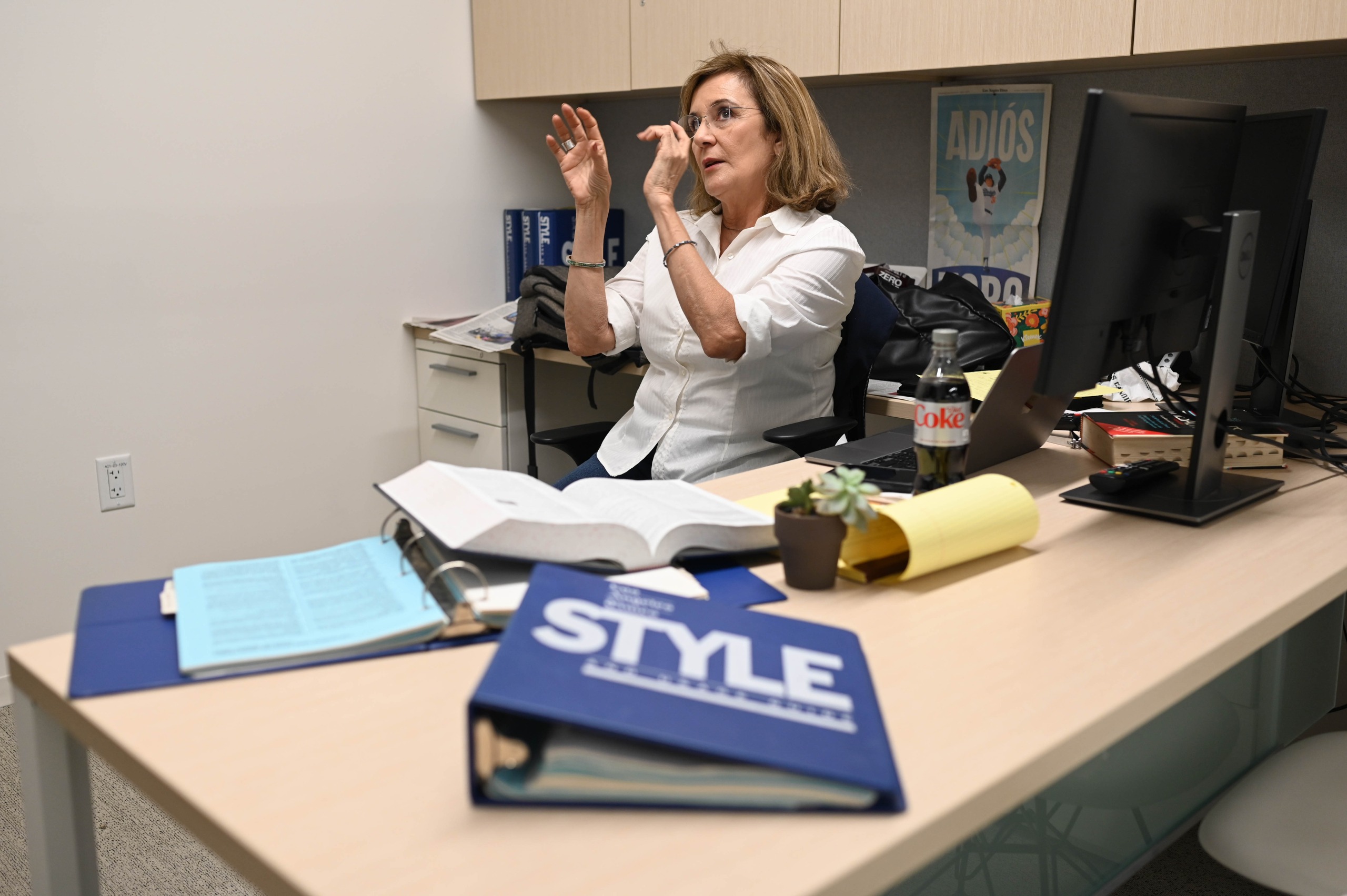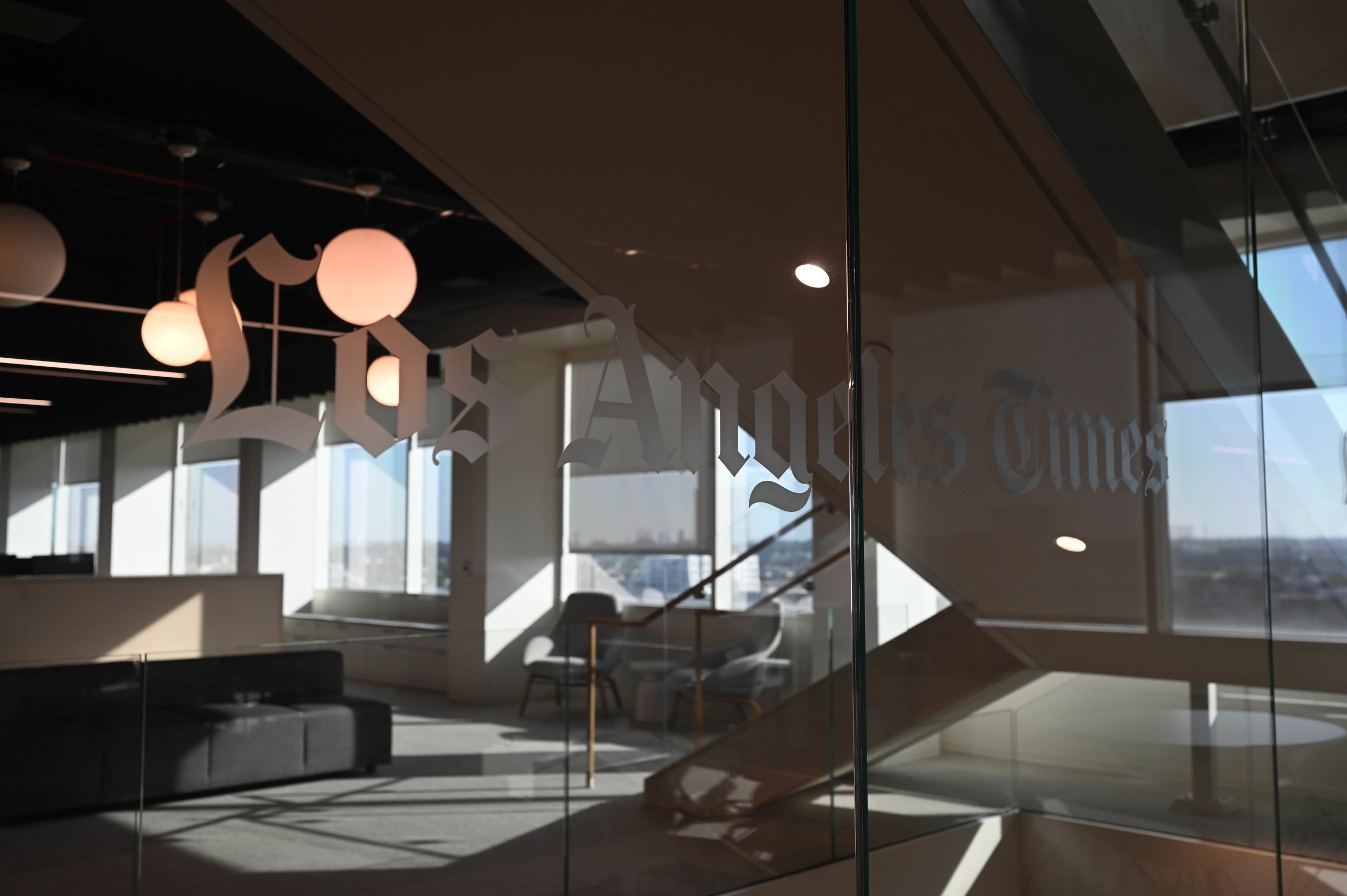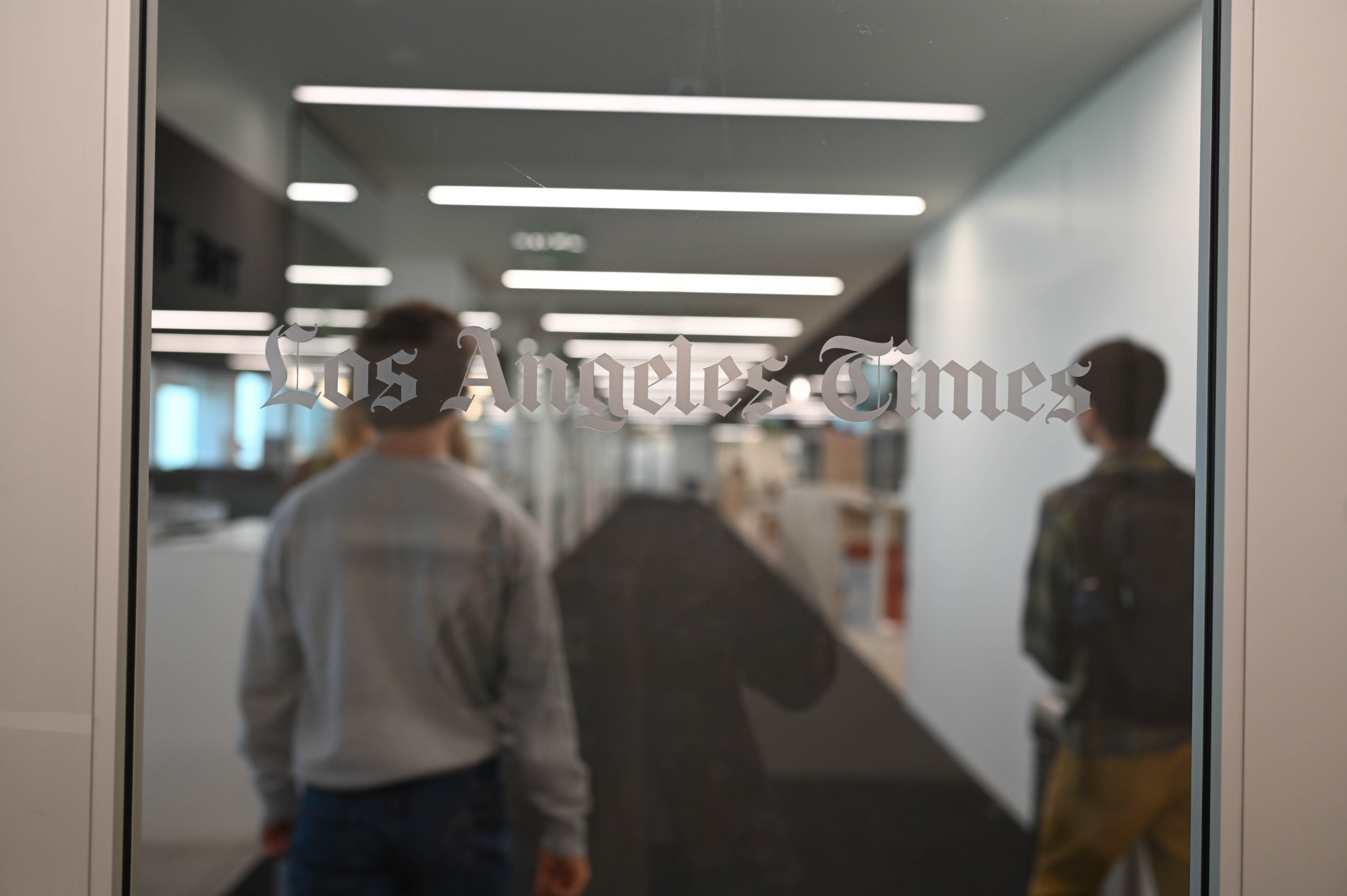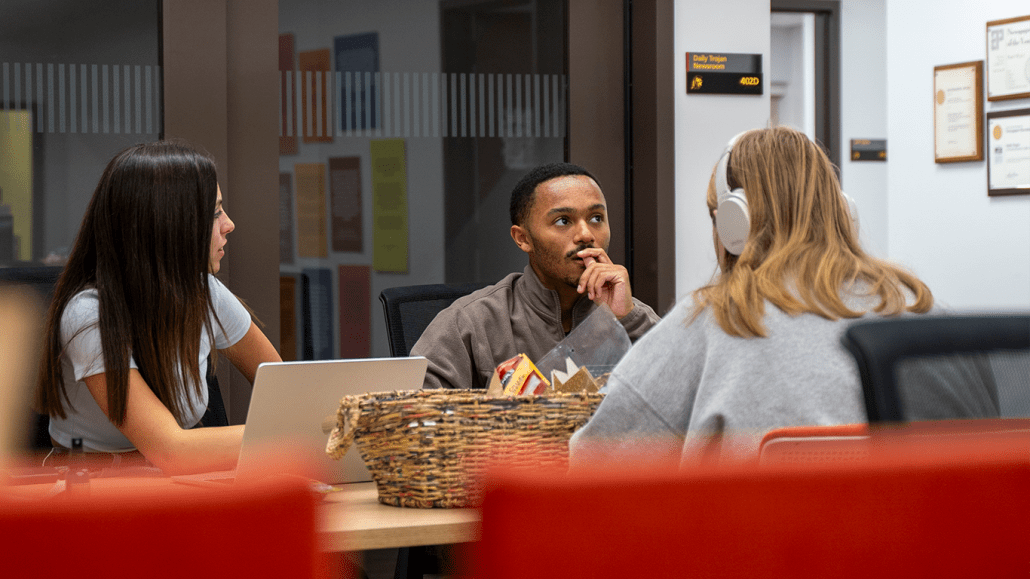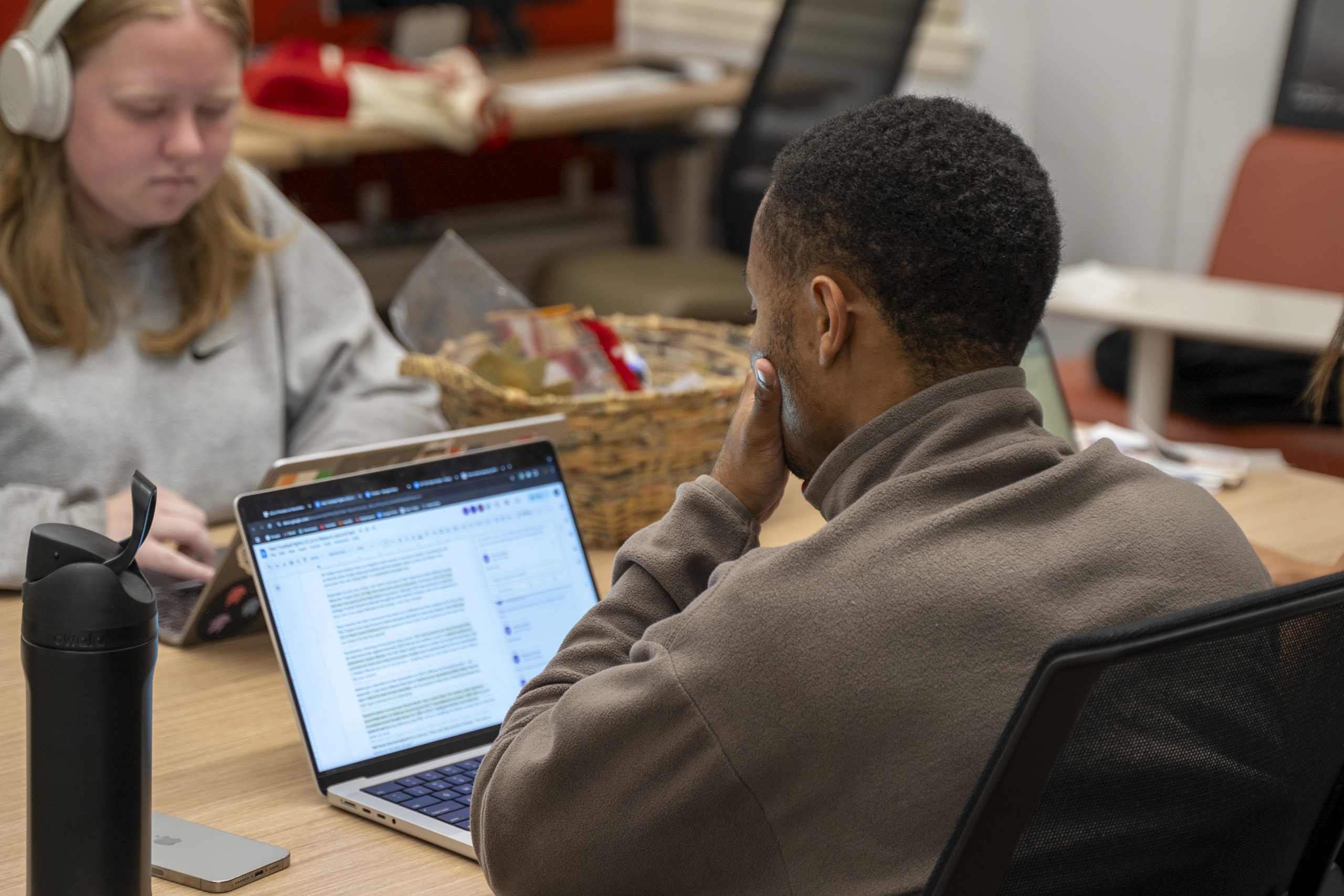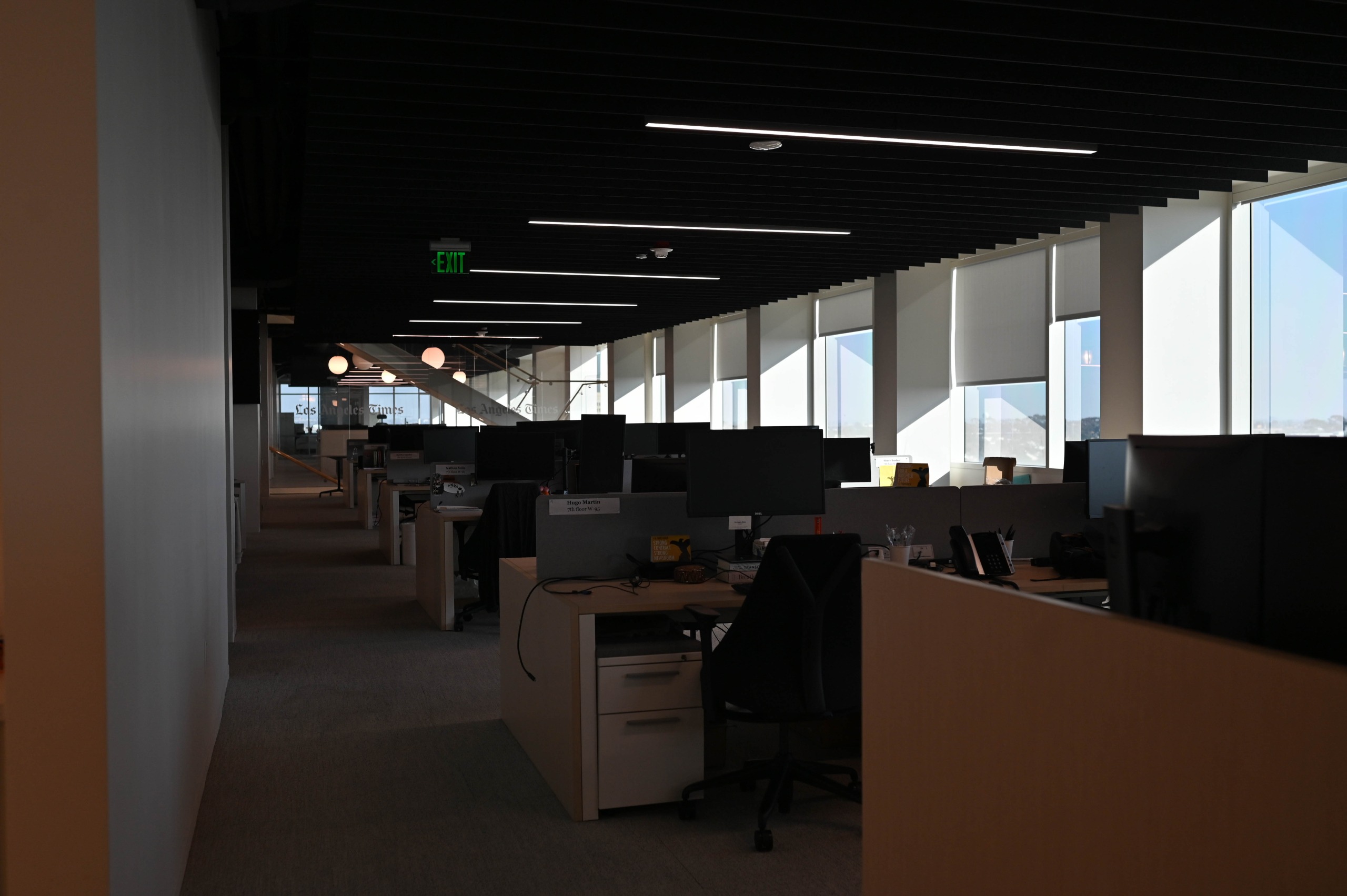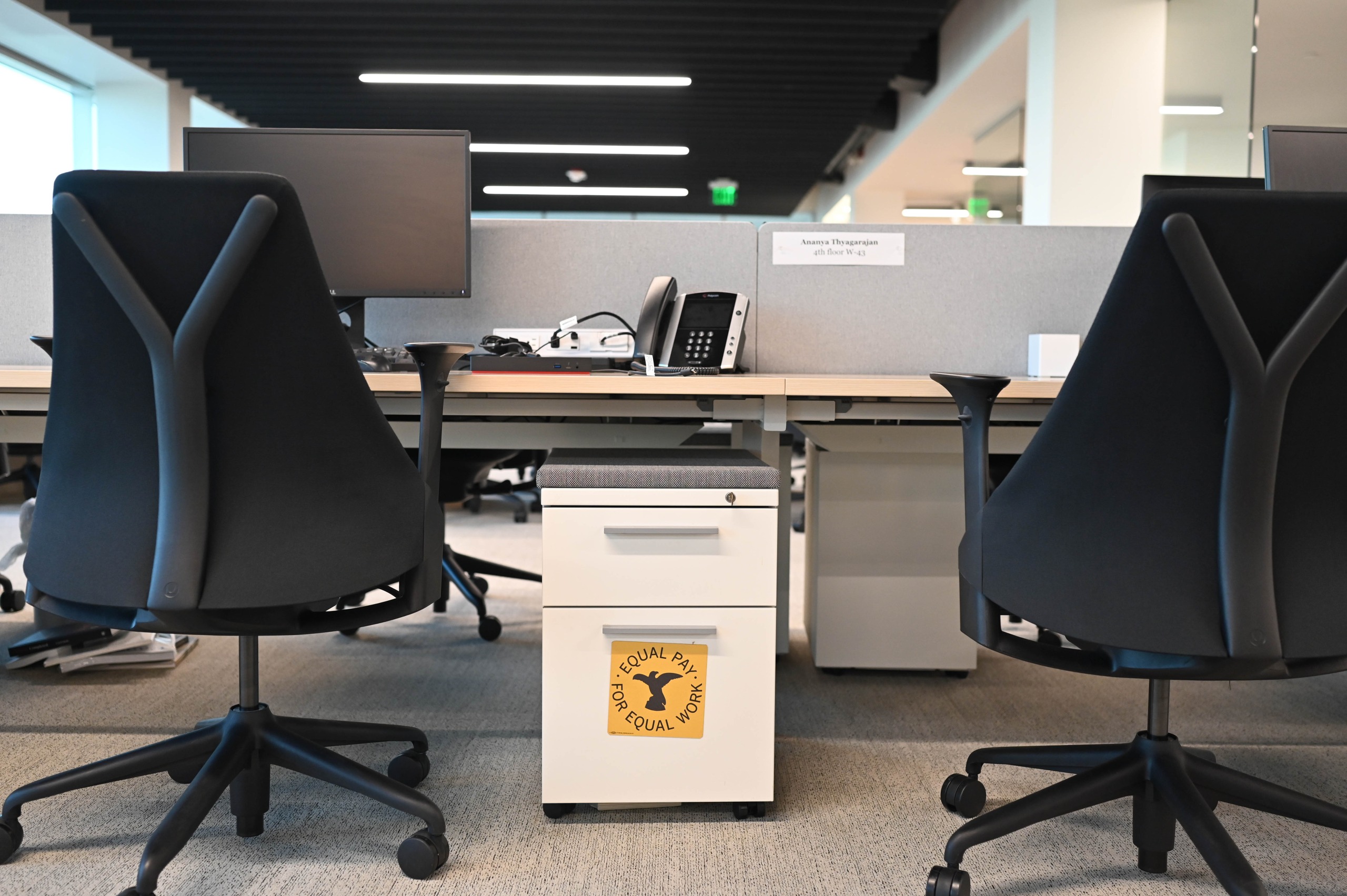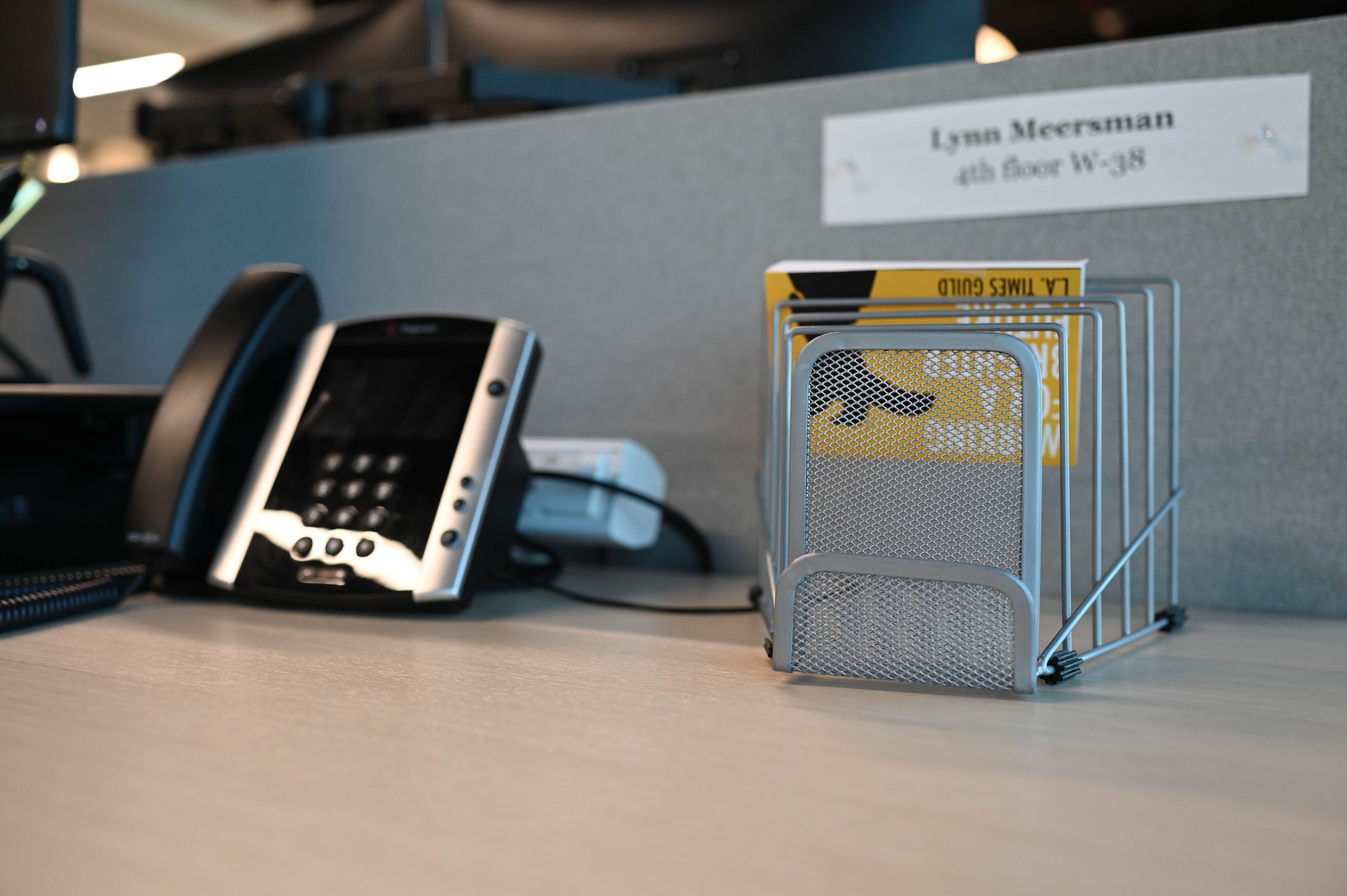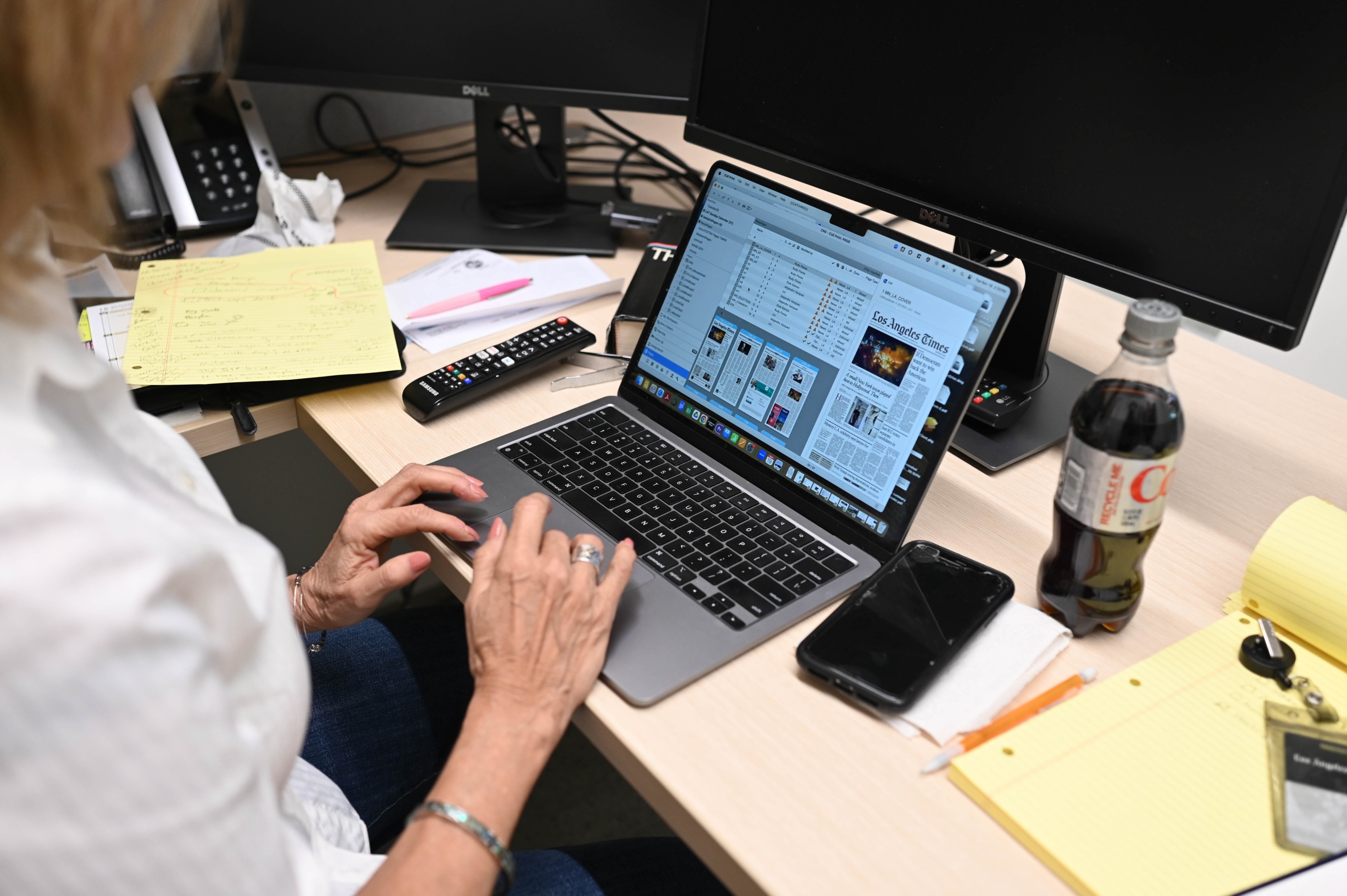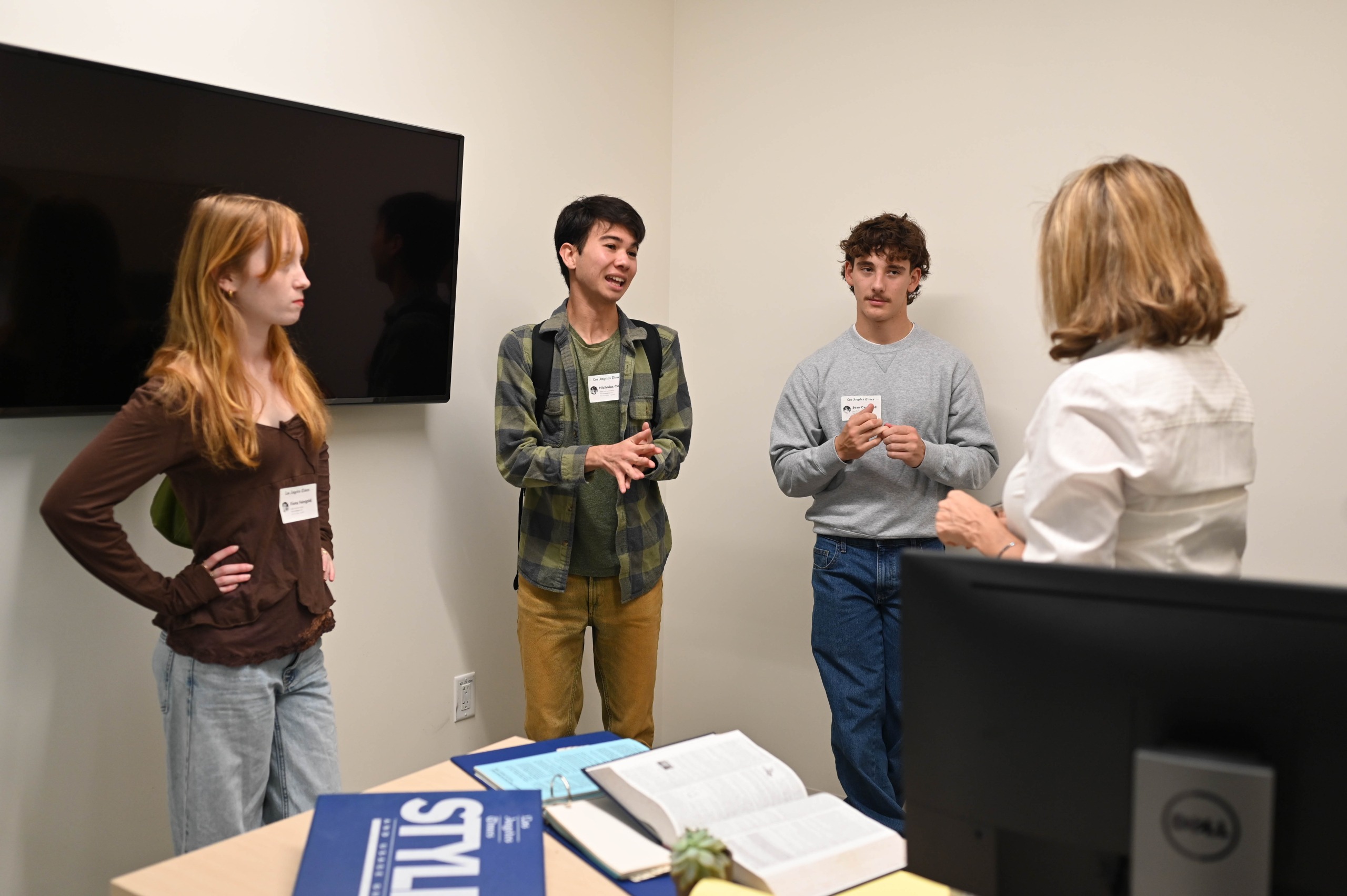Editors wrestle with the future of copy editing amid the rise of generative AI and newsroom layoffs.
By DEON BOTSHEKAN, NICHOLAS CORRAL & FIONA FEINGOLD
Kayden Harmony / Daily Trojan
The year was 1997. ACES: The Society for Editing — formerly known as the American Copy Editors Society — was founded as a nonprofit organization dedicated to promoting excellence in copy editing.
Melissa McCoy, one of the founding members of the organization, was the foreign desk copy chief at the Los Angeles Times. She said the group came out of an American Society of News Editors summit that revealed the importance of copy editors to the newsroom.
“It just made all the difference because they went back to their individual newsrooms and really made more of an effort to show the work that copy editors did,” said McCoy, now an adjunct professor at the Annenberg School for Communication and Journalism. “It can be very silent work … Can you imagine if a copy editor held their hand up every time they could fix something in a story? There would be hands raised all over newsrooms every day.”
Flash forward 27 years, and the work of professional editors has become all too necessary. In a world with newsroom layoffs, rampant misinformation and artificial intelligence on the rise, the work of copy editors is more important than ever.
Kayden Harmony / Daily Trojan
Often overlooked, copy editors are largely responsible for preventing both factual and grammatical errors from appearing in print. Editors fact-check information and ensure articles adhere to Associated Press and publication-specific style guidelines. At many publications, copy editors take a greater role in layout design by writing headlines and trimming articles as needed for space.
The Daily Trojan currently employs 30 copy staff — 25 copy editors, three deputy copy editors and two copy chiefs. Deputy copy editors are also on call for breaking news, often verifying information as it is being discovered. The copy team looks at every article three times before an issue hits newsstands; the chief copy editor on shift is usually the last person to read through an article before it is sent for print.
At the L.A. Times office in El Segundo, you would find much the same situation, down to the number of copy editors on staff. That’s right — a national paper of record has nearly the same number of copy editors as a college paper.
Jake Berg / Daily Trojan
Ruthanne Salido, an assistant managing editor at the L.A. Times overseeing its multiplatform editing desk, said there were over a hundred copy editors at the L.A. Times when she started in 1989.
Layoffs over the years — particularly in July 2023 and again this January — cut the size of the copy desk, and today the L.A. Times lists 34 multiplatform editors on its staff.
These cutbacks have not only hit copy desks. A Pew Research Center analysis found employment at newspapers dropped by 51% from 2008 to 2019. Les Dunseith, a former copy editor and adjunct instructor, said newsrooms are likely to prioritize keeping content producers.
“When most people think of journalism, they think of reporters first,” Dunseith said. “Anyone who was not doing a reporting job was more likely to have their job be among the first to be trimmed when cutbacks happen.”
In 2017, The New York Times eliminated its copy desk of over 100 people as a separate part of the newsroom, folding the responsibilities into desks that edit content and style simultaneously. The Texas Tribune also eliminated its entire copy desk in 2023.
Elise De Los Santos, a former copy editor at the Chicago Tribune and a journalism professor at Northwestern University, said the typical position of copy editing has all but disappeared.
“The traditional role of being strictly on the print product and just copy editing stories for print … If that’s all you’re interested in doing, I don’t think that job really exists anymore,” De Los Santos said.
Jake Berg / Daily Trojan
Annenberg itself no longer requires its journalism students to study copy editing. Around the turn of the century, required copy editing courses — along with other print-centric courses like page layout — became elective courses, and over the next decade, copy editing fell out of course offerings altogether.
Laura Castañeda, former associate director of the journalism school at Annenberg, said the decision was made to make room for other courses in multimedia and internet journalism as those aspects became more important in the early 2000s.
“There’s all kinds of interesting classes out there. A lot of them are kind of technology-driven,” Castañeda said. “Many students don’t want to take copy editing. It’s not, I guess, considered very sexy.”
Dunseith said he last taught a course in copy editing in Spring 2017, and even then, it was offered as a seven-week special topic course. Only six students enrolled.
Kayden Harmony / Daily Trojan
The growth of AI technology, and particularly its generative abilities, has raised concerns about the future of careers in journalism. These fears are particularly great in copy editing, which has already seen large cutbacks.
De Los Santos said the Tribune’s interest in AI primarily lay in its potential as a headline development tool. Using A/B testing, the publication experimented with showing readers different headlines and comparing their varying effectiveness. During De Los Santos’ tenure, which ended in 2021, the Tribune avoided the use of generative AI.
“Newsrooms, especially at legacy corporations, like the Tribune, which is building off of a traditional newsroom structure, I think they remain pretty wary of [AI] but know that it’s something that they have to know about and learn how to use in a way that’s ethical,” said De Los Santos.
Ananya Thyagarajan, a 2023-24 multiplatform editing fellow at the L.A. Times, said copy editors have a unique ability to interact with language that AI will never replicate.
“AI is never going to be able to have the kinds of thoughtful discussions around language that the copy editors have when we make changes to the style guide,” Thyagarajan said. “AI is never going to suggest capitalizing the ‘B’ in Black. It’s never going to think to be innovative or sensitive in language in a way that it hasn’t been trained to.”
Kayden Harmony / Daily Trojan
De Los Santos reiterated the importance of being precise with language.
“There’s a lot of assumptions that sometimes get baked into news because of just how fast paced it is. And things like that, being, just, aware about the questions we should ask and that how we describe people [matters] to them and to everyone reading about them — I think it’s one really important role that copy editing … helps to play in journalism,” De Los Santos said.
Meanwhile, Salido said part of the continued value of copy editors is the ability to work with reporters to make sure that content edits are correct.
“We’re resilient or adaptable. When we don’t get quite the answer we want from a reporter or line editor, we push and we push and we pursue and pose the question a different way,” Salido said. “I don’t know if an AI can do all that.”
Alongside the increasing popularity of AI, the role of copy editors has changed following the growing threat of misinformation. Brian Cleveland, copy desk chief at The Washington Post, described copy editing as integral to combatting the dangers of misinformation.
“Building and maintaining that trust and relationship with people is the only way to break through all the noise. Copy editors have always been key to establishing that trust through the work that we do and the quality control that we provide,” Cleveland said.
Kayden Harmony / Daily Trojan
Cutbacks to copy desks, however, have often meant asking reporters and line editors — editors who work with the reporter to first shape the piece — to do more of their own copy editing.
“The defined role of what it means to be a reporter has expanded in the last decade or so,” Dunseith said. “There’s much more expectation that reporters know how to write their own headlines and know how to handle their own social media accounts and do their own podcasts and some of those kinds of things that would have been handed off to a copy editor.”
Laura E. Davis, another professor at Annenberg, created Stylebot — a system that recognizes user text inputs to suggest relevant information about style. The system is targeted toward writers, reporters and line editors. She said she created the program to deal with the added time pressures she saw with reporting in the digital age.
“Stylebot is not about taking humans out of the process,” Davis said. “It’s acknowledging that more and more, because of the pace of publishing, because of the demands of multiplatform publishing, editing is a little bit more of everybody’s job.”
Davis said the greater impact of AI might be an increase in editing responsibilities — even if those roles aren’t distributed to traditional copy desks.
“If AI is doing more writing, then people are doing more editing,” Davis said. “These editing skills and really knowing your stuff is actually important because there’s not a system out there right now that’s going to automate it for you and get it exactly right every single time.”
De Los Santos doesn’t think aspiring student journalists should be scared of the growing importance of copy editing for everyone.
“The jobs that they are probably looking for … will require some level of copy editing because as that traditional role of just copy editor has changed and evolved, a lot of the responsibilities also shift onto the reporter or entry-level editor,” De Los Santos said.
Kayden Harmony / Daily Trojan
Salido also said she doesn’t expect copy editing to disappear any time soon. She said that despite cuts to the copy desk, reporters want their work copy edited and the desk has been busier than ever.
“In theory, yes, we could do without the copy desk, but nobody really seems to want their material not copy edited,” Salido said. “It’s just the opposite … They want to know, ‘Do we have the manpower to copy edit this?’”
As Thyagarajan nears the end of her fellowship at the L.A. Times, she said she plans to look for jobs outside of editing because of the cutbacks in the industry. In college, she majored in public health and environmental studies.
“The unfortunate truth is that copy editing is really not an industry that is doing well or even remotely okay right now,” Thyagarajan said. “There is always going to be a need for journalism, and that need is going to be fulfilled somehow, but I don’t think that there’s any stability or any security in pursuing editing in a career format. So for me, what that means is staying flexible and looking for opportunities elsewhere.”
In other ways, this change in responsibility has opened new doors for journalists striving to make themselves known in a notoriously difficult industry.
“I know it’s scary, but I also say there’s a lot of opportunity,” De Los Santos said. “If you are someone who can dot their i’s and cross their t’s, that makes you stand out a little bit more among a big application pool.”
Despite the changes to copy editing and industry-wide struggles, Salido remains committed to her work and the future of copy editing.
“Reporters, line editors and copy desk people — there are fewer of us all,” she said. “But we’re busier than ever because we’re in a fight for our lives. We do want to survive as a newspaper, as a company. We’re doing everything we can to try to survive and thrive. And we believe in journalism.”
Jake Berg / Daily Trojan
Disclaimer: Les Dunseith serves as faculty adviser at the Daily Trojan. He is not involved in content decisions.
Deon Botshekan is a staff writer for the Daily Trojan Magazine and chief copy editor at the Daily Trojan. Botshekan is a junior majoring in philosophy, politics and economics.
Nicholas Corral is a staff writer for the Daily Trojan Magazine and a News editor at the Daily Trojan. Corral is a sophomore majoring in journalism.
Fiona Feingold is a staff writer for the Daily Trojan Magazine and chief copy editor at the Daily Trojan. Feingold is a sophomore majoring in public relations and advertising.
Editor’s Note: This story was updated on Wednesday, December 11 at 10:18 p.m. to change the phrase “fake news” to “misinformation” to portray an interviewee’s statements more accurately.
Correction: This article was changed on Thursday, December 12 at 2:26 p.m. to state that Melissa McCoy was a founding member of ACES, not a co-founder of the organization. The Daily Trojan regrets this error.

